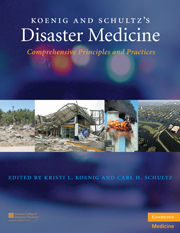Book contents
- Frontmatter
- Contents
- List of Contributors
- Contributor Biographies
- Foreword
- Preface
- Acknowledgments
- PART I CONCEPTUAL FRAMEWORK AND STRATEGIC OVERVIEW
- PART II OPERATIONAL ISSUES
- 9 Public Health and Emergency Management Systems
- 10 Legislative Authorities and Regulatory Issues
- 11 Syndromic Surveillance
- 12 Triage
- 13 Personal Protective Equipment
- 14 Decontamination
- 15 Quarantine
- 16 Mass Dispensing of Antibiotics and Vaccines
- 17 Management of Mass Gatherings
- 18 Transportation Disasters
- 19 Emergency Medical Services Scene Management
- 20 Healthcare Facility Disaster Management
- 21 Mass Fatality Management
- 22 Crisis and Emergency Risk Communication
- 23 Telemedicine and Telehealth Role in Public Health Emergencies
- 24 Complex Public Health Emergencies
- 25 Patient Identification and Tracking
- PART III CLINICAL MANAGEMENT
- Index
- Plate section
- References
9 - Public Health and Emergency Management Systems
from PART II - OPERATIONAL ISSUES
Published online by Cambridge University Press: 05 August 2011
- Frontmatter
- Contents
- List of Contributors
- Contributor Biographies
- Foreword
- Preface
- Acknowledgments
- PART I CONCEPTUAL FRAMEWORK AND STRATEGIC OVERVIEW
- PART II OPERATIONAL ISSUES
- 9 Public Health and Emergency Management Systems
- 10 Legislative Authorities and Regulatory Issues
- 11 Syndromic Surveillance
- 12 Triage
- 13 Personal Protective Equipment
- 14 Decontamination
- 15 Quarantine
- 16 Mass Dispensing of Antibiotics and Vaccines
- 17 Management of Mass Gatherings
- 18 Transportation Disasters
- 19 Emergency Medical Services Scene Management
- 20 Healthcare Facility Disaster Management
- 21 Mass Fatality Management
- 22 Crisis and Emergency Risk Communication
- 23 Telemedicine and Telehealth Role in Public Health Emergencies
- 24 Complex Public Health Emergencies
- 25 Patient Identification and Tracking
- PART III CLINICAL MANAGEMENT
- Index
- Plate section
- References
Summary
INTRODUCTION
Emergency management has always included a component that addresses the health of the public. The major concern during an emergency, whether in the form of a hazardous materials incident, terrorist event, disease outbreak, or other type of disaster, is its potential to harm the health and well-being of people. A formalized system that connects “emergency management” and “public health,” however, did not begin to emerge until the latter part of the 20th century. At this time, healthcare leaders and policymakers began promoting standardized processes and assigning functional responsibilities to specific government agencies and entities, ensuring consistent inclusion of the public health component in the management of emergencies. The result has been the creation of programs and implementation of concepts that, when appropriately applied, ensure accomplishment of the ultimate goal of managing emergencies. The final outcome of these processes is the reduction of morbidity and mortality and return of circumstances to the preemergency state or better.
This chapter addresses concepts and issues that are essential for understanding how public health integrates with emergency management at all levels and in varying emergency circumstances. It focuses on the following
1) A general overview of public health and emergency management systems and how they interface
2) Comprehensive Emergency Management, including the all-hazards approach
3) The Incident Command (Management) System, including the adoption within the United States of the National Incident Management System (NIMS)
4) Interconnectivity of healthcare systems as it relates to public health and emergency management systems and activities
[…]
Keywords
- Type
- Chapter
- Information
- Koenig and Schultz's Disaster MedicineComprehensive Principles and Practices, pp. 133 - 150Publisher: Cambridge University PressPrint publication year: 2009



